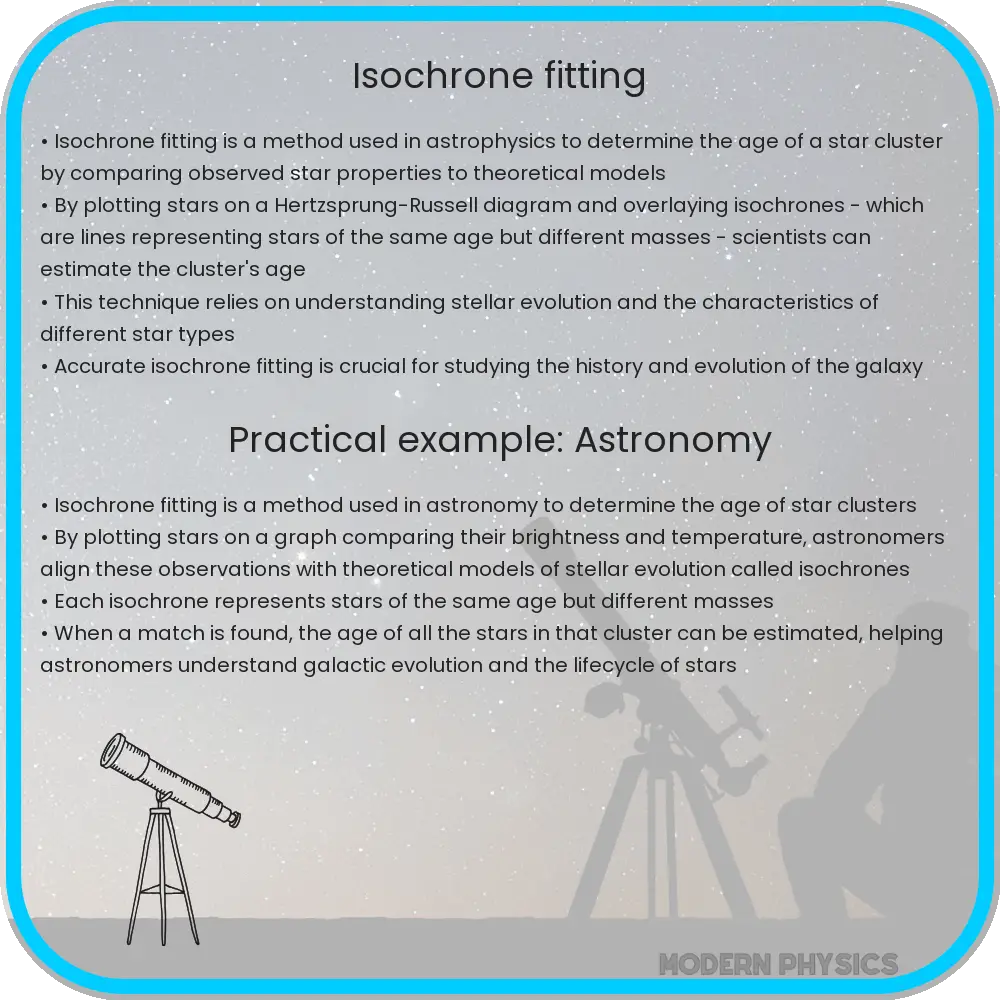Explore isochrone fitting, a key method in stellar astronomy for determining the ages of stars and understanding their evolution, along with recent advancements.

Understanding Isochrone Fitting in Stellar Astronomy
Isochrone fitting is a vital tool in stellar astronomy, enabling scientists to determine the ages of star clusters and understand stellar evolution. This method leverages the theoretical models of stellar evolution, comparing them with actual observations to gauge the age and development stage of stars. This process is crucial for mapping the life cycle of stars and understanding the dynamics of galactic evolution.
The Principles of Isochrone Fitting
At its core, isochrone fitting involves comparing a set of theoretical isochrones—curves representing stars at the same age but different masses—to the observed color-magnitude diagrams (CMDs) of star clusters. Isochrones are generated from stellar evolution models and predict the luminosity and temperature (or equivalently, color and magnitude) of stars at different points in their life cycles. By matching these theoretical curves to actual observations, astronomers can estimate the age of a star cluster. The better the fit between the model and the observational data, the more accurate the age estimation.
Applications and Challenges
The method has wide-ranging applications, from dating star clusters in our own Milky Way to studying distant galaxies. Through isochrone fitting, astronomers can piece together the history of star formation in the universe, contributing to our understanding of cosmic evolution. However, the process is not without its challenges. The accuracy of age determination through isochrone fitting heavily depends on the precision of the observational data and the assumptions underlying stellar evolution models.
Determining stellar ages accurately is crucial for many areas of astrophysics, as it helps in the understanding of stellar populations, galactic evolution, and the chemical enrichment of the universe. Yet, the method’s efficacy can be compromised by uncertainties such as distance measurements, interstellar extinction, and the chemical composition of the stars being studied.
Moreover, the development of comprehensive stellar models that account for factors like mass loss, rotation, and magnetic fields adds layers of complexity to isochrone fitting, requiring constant refinement and testing against observations.
Advancements in Isochrone Fitting Techniques
Recent advancements in technology and methodology have significantly improved the precision of isochrone fitting. High-resolution telescopes and detectors provide clearer and more detailed observations, while advances in computing allow for more complex and comprehensive stellar models. Additionally, the advent of machine learning techniques in astronomy offers new ways to analyze and interpret large datasets, potentially leading to more accurate age estimations.
Moreover, interdisciplinary approaches combining data from asteroseismology, spectroscopy, and cluster dynamics are enhancing the robustness of age determinations. These methods help to overcome some of the limitations of traditional isochrone fitting by providing additional constraints on the properties of stars and star clusters.
Future Directions
The future of isochrone fitting and stellar age determination looks promising as methodologies continue to evolve. Ongoing and upcoming astronomical surveys, such as those conducted by the Gaia mission, are expected to provide vast amounts of data that will further refine our understanding of stellar evolution and improve the accuracy of age measurements. As models become more sophisticated and data more abundant, the field is moving towards a more integrated approach, combining various lines of evidence to build a coherent picture of stellar and galactic history.
Conclusion
Isochrone fitting is a cornerstone of stellar astronomy, providing valuable insights into the ages and evolution of stars and galaxies. Despite its challenges, the method has seen significant advancements, thanks to improvements in observational capabilities, computational techniques, and theoretical models. The integration of various astronomical disciplines promises even greater accuracy and depth in our understanding of the cosmos. As we stand on the brink of a new era of astronomical discovery, isochrone fitting remains an essential tool in our quest to unravel the mysteries of the universe.
